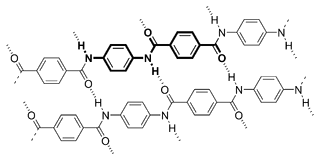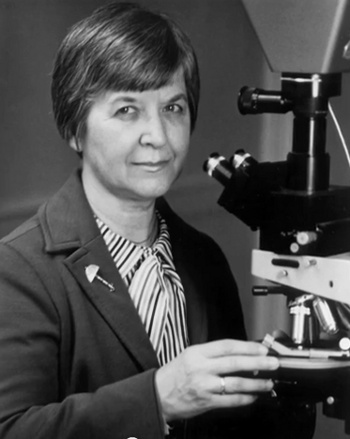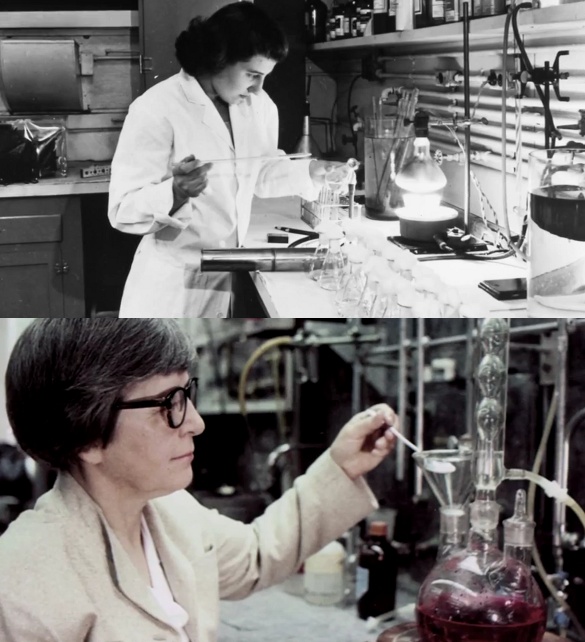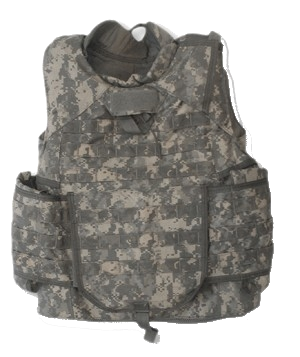Kevlar® Inventor, Stephanie Kwolek
June 23, 2014
Founded in 1802,
Dupont (more properly, E.I. du Pont de Nemours and Company), is one of the world's largest
chemical companies. It has about $35 billion in
annual revenue, and its major business has been
chemistry; so much so, that its
slogan from 1935-1982 was "
Better Things for Better Living...Through Chemistry. The short form, "Better Living Through Chemistry," was used as the title of a
recent movie.[1]
Dupont has developed many important
materials, several of which are known to the general public. These include
nylon,
Corian,
Teflon,
Mylar and
Lycra.
Vespel,
neoprene,
Nomex and
Tyvek, are some of its other materials known to most
engineers.

Kevlar derives its strength from the inter-chain bonds shown here.
(Via Wikimedia Commons.)
One of Dupont's materials is
Kevlar, the
para-aramid polymer, poly-paraphenylene terephthalamide, composed of
chains of the chemical unit,
-CO-C6H4-CO-NH-C6H4-NH-. Because of inter-chain bonding, as shown in the above figure, Kevlar has a ratio of
tensile strength per
weight (
specific strength) that's five times that of
steel. Not only that, it's a useful material from
cryogenic temperature up to about 150
°C.
Inventor of Kevlar,
Stephanie Kwolek, died on June 18, 2014, at age 90.[2-5]

Stephanie Louise Kwolek (July 31, 1923-June 18, 2014)
(Still image from a YouTube Video by the Chemical Heritage Foundation.[6]
Stephanie Louise Kwolek was born on July 31, 1923, in a suburb of
Pittsburgh, Pennsylvania. Her
parents were both
Polish immigrants to the United States. The
family name was
anglicized from Chwałek. Her
father was an
amateur naturalist, and she attributed her interest in
science to her
Nature expeditions with him.
Kwolek's initial ambition was to become a
physician, so after getting a degree in
chemistry from what is now
Carnegie Mellon University in 1946, she took a job with Dupont in order to save money for
medical school. She discovered, however, that she enjoyed the work, and she eventually relocated from the Dupont facility in
Buffalo, New York, to
Wilmington, Delaware, in 1950. She worked at Dupont's Wilmington, Delaware,
research facility for forty years, where she was head of polymer research at her
retirement in 1989.[2,4]

At home in the laboratory, both early in her career and later. Note the absence of safety glasses in the older photograph. Laboratory safety practices have improved over the years, but gloves were still absent in the more modern image. (Still images from a YouTube Video by the Chemical Heritage Foundation.[6]
In 1964, Kwolek was doing research on new polymer materials as a lightweight replacement for steel
wires used for
automobile tire reinforcement. While investigating polymers that could be processed at lower temperatures, a condition that leads to higher strength, her research team found that the Kevlar material had unique
mechanical properties. This research led to Dupont's manufacture and sale of Kevlar for many applications.[5]
The Kevlar material was unique, since it was spun from a
liquid crystal solution that was so unusual that most
chemists would have discarded it as useless.[2] It was very thin solution, and it had a cloudiness that resembles solutions containing
suspended solids. Such solids would block the fine holes in the
spinneret used to make polymer fibers.[6]
Kwolek, in a 2007
interview in
The News Journal, a Wilmington, Delaware, newspaper, said that Kevlar was so unusual that she needed to do repeated
confirmatory experiments to convince herself of the results. When she was certain that she wouldn't embarrass herself to Dupont's
management, she presented her results, and Dupont immediately assigned many people to develop the material. Kwolek was always careful to acknowledge her
collaborators in Kevlar development.[3]
Kevlar's been used in a plethora of products, including
insulation for
underwater optical-fiber cables,
tire cord,
drumheads,
baseball bats,
ship hulls,
skis, and
space suits.[3,5,8] One application has been in so-called
"bullet-proof" vests, more properly called "lightweight body armor," for both
police and
military.

An Improved Outer Tactical Vest (IOTV).
The difference in soldier dress between World War II and one of our many, present wars is amazing.
(Via Wikimedia Commons.)
By Dupont's estimate, more than 3,100
law enforcement officers have escaped
death or serious
injury through use of Kevlar
body armor.[5] Kwolek is quoted by the Chemical Heritage Foundation as saying, "I don't think there's anything like saving someone's life to bring you satisfaction and happiness."[8] Dupont just announced the sale of more than a million bullet-resistant vests made from an advanced Kevlar material since it was produced in 2008. The army of the
Republic of Korea was the recipient of the millionth vest.[9]
In 1995, Kwolek became the fourth
woman to be added to the
National Inventors Hall of Fame, and she was awarded the
National Medal of Technology in 1996. Kwolek was also awarded the 1997
Perkin Medal from the
American Chemical Society, and she was a named inventor on 28
patents (the "Kevlar" patent is 71 pages long).[4]
She was elected to the
National Academy of Engineering in 2001.
References:
- Better Living Through Chemistry (2014, Geoff Moore and David Posamentier, Directors) on the Internet Movie Database.
- Camila Domonoske, "Stephanie Kwolek, Chemist Who Created Kevlar, Dies At 90," NPR, June 20, 2014.
- Will Dunham, "Stephanie Kwolek, American chemist who invented Kevlar, dies at 90," Reuters, June 21, 2014.
- USA: zmarła Stephanie Kwolek, wynalazczyni kevlaru, Radio Poland, June 21, 2014.
- Randall Chase, "5 Things To Know about Kevlar," Bismark Tribune, June 20, 2014.
- Women in Chemistry: Stephanie Kwolek, Chemical Heritage Foundation, YouTube Video, September 10, 2012.
- Stephanie Louise Kwolek,"Wholly aromatic carbocyclic polycarbonamide fiber having orientation angle of less than about 45°," US Patent No. 3,819,587, June 25, 1974.
- Stephanie Kwolek, Chemical Heritage Foundation Web Site.
- DuPont Announces Millionth Vest Made with DuPont™ Kevlar® XP™, Dupont Press Release, June 18, 2014.
Permanent Link to this article
Linked Keywords: Dupont; chemical industry; chemical company; annual; revenue; chemistry; slogan; Better Things for Better Living...Through Chemistry; Better Living Through Chemistry; material; nylon; Corian; polytetrafluoroethylene; PTFE; Teflon; BoPET; Mylar; Spandex; Lycra; Vespel; neoprene; Nomex; Tyvek; engineer; polymer chain; chemical bond; Wikimedia Commons; Kevlar; para-aramid; polymer; ultimate tensile strength; weight; specific strength; steel; cryogenic; temperature; celsius; °C; invention; inventor; Stephanie Kwolek; YouTube Video; Chemical Heritage Foundation; Pittsburgh, Pennsylvania; parent; Poland; Polish; immigrants; United States; family name; English exonym; father; amateur; natural history; naturalist; science; Nature; physician; chemistry; Carnegie Mellon University; medical school; Buffalo, New York; Wilmington, Delaware; research; retirement; laboratory; career; safety glasses; photograph; safety; glove; YouTube Video; wire; automobile; tire; mechanical property; liquid crystal; solution; chemist; suspended solids; spinneret; interview; The News Journal; reproducibility; confirmatory experiment; management; collaboration; collaborator; insulation; underwater; optical-fiber cable; tire cord; drumhead; baseball bat; ship hull; ski; space suit; "bullet-proof" vest; police; military; Improved Outer Tactical Vest; soldier; World War II; war; law enforcement officer; death; injury; body armor; South Korea; Republic of Korea; woman; National Inventors Hall of Fame; National Medal of Technology; Perkin Medal; American Chemical Society; patent; National Academy of Engineering; Better Living Through Chemistry (2014, Geoff Moore and David Posamentier, Directors).